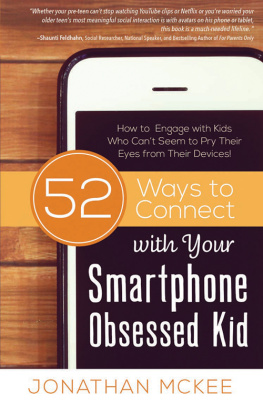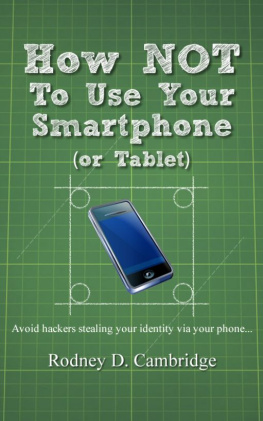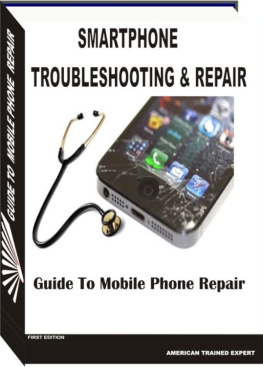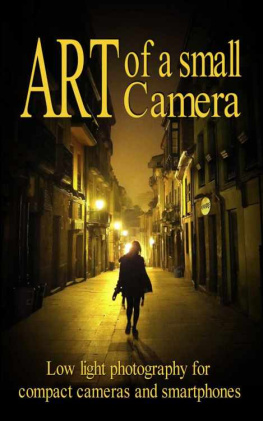The Smartphone


2014 by Elizabeth Woyke
All rights reserved.
No part of this book may be reproduced, in any form, without written permission from the publisher.
Requests for permission to reproduce selections from this book should be mailed to: Permissions Department, The New Press, 120 Wall Street, 31st floor, New York, NY 10005.
Published in the United States by The New Press, New York, 2014
Distributed by Perseus Distribution
LIBRARY OF CONGRESS CATALOGING-IN-PUBLICATION DATA
Woyke, Elizabeth.
The smartphone : anatomy of an industry / Elizabeth Woyke.
pages cm
Includes bibliographical references and index.
ISBN 978-1-59558-968-2 (e-book) 1. Smart phones. 2. Cell phones. 3. Telecommunication. 4. Electronic industries. I. Title.
HE9713.W69 2014
384.5'34dc23
2014020781
The New Press publishes books that promote and enrich public discussion and understanding of the issues vital to our democracy and to a more equitable world. These books are made possible by the enthusiasm of our readers; the support of a committed group of donors, large and small; the collaboration of our many partners in the independent media and the not-for-profit sector; booksellers, who often hand-sell New Press books; librarians; and above all by our authors.
www.thenewpress.com
Composition by dix!
This book was set in Minion
10 9 8 7 6 5 4 3 2 1
For my parents, John and Priscilla
Contents

Martin Cooper with Motorolas DynaTac prototype in 1973 (Martin Cooper)
On April 3, 1973, Martin Cooper dialed his way into history. As the general manager of Motorolas systems division, he had flown to New York City to unveil a prototype of the worlds first handheld cellphone. The 28-ounce phone, which had a long antenna, a thin body, and a protruding bottom lip, making it resemble a boot, isnt sleek by current standards, but it was revolutionary. Until 1973 a mobile phone required so much power it had to be tethered to a cars electrical system or an attach case containing a huge battery. The phone that Cooper and his team had developedthe DynaTACfit right in the palm of his hand.
Cooper got lucky. The phone functioned flawlessly that day, both before the press conference when he placed a call from the bustling street in front of a reporter, and later at the event, where he made a number of calls, even letting one young journalist dial her mother in Australia. At that time, not everyone in the world thought people needed cellphones, he said, but the reporters were quite enthusiastic. Today Cooper is universally acknowledged as the creator of the cellphone and the first person to make a cellphone call in public. His story gave the world a straightforward starting point for understanding cellphone history.
In contrast, there is no consensus on the smartphones origins. A number of people think it was born in 2007, when Apple cofounder Steve Jobs proudly showed off the first iPhone at the Macworld conference in San Francisco. But what many people either forget or do not know is that phones with smartphone features had already been on sale for more than a decade.
Some experts believe smartphones emerged from cellphones when manufacturers began squeezing sophisticated programs and Web-browsing features into their handsets. Others say personal digital assistants (PDA), with their touchscreens and open operating systems, were the real progenitors of the smartphone. A third camp thinks pagers and messaging devices, including early BlackBerrys, paved the way by introducing mobile data and e-mail to a broad audience.
The question hangs on how you define a smartphone. Generally speaking, a smartphone distinguishes itself from a cellphone by running on an open operating system that can host applications (apps) written by outside developers. The apps expand the phones functionality, giving it computerlike capabilities, and can be downloaded and installed by users, not just pre-installed by smartphone companies. Smartphones also have a number of built-in features that basic phones typically do not, including touchscreens that can sense multiple-finger swipes, high-definition displays, fully Internet-capable browsers, advanced software that automatically grabs new e-mails, and high-quality cameras, music, and video players.
It took more than a decade to cram all these features into one handheld device. The earliest smartphones came from IBM, Nokia, Ericsson, Palm, and Research In Motion/BlackBerry. Though these phones pushed boundaries in the 1990s and early 2000s, they were all limited in some way, especially in their Internet and app access. Most of these early smartphones were not sales hits. Some were famous flops. But all contributed to the smartphones we now carry in our pockets, whether they are iPhones, Android phones, Windows Phones, or BlackBerrys.
IBM AND THE SIMON
IBMs Simon phone was born of twin desires: a talented engineers to tackle the challenge of creating a portable, wirelessly connected computing device and IBMs to burnish its image by unveiling never before seen, futuristic gadgets. Though the Simon was commercially available for less than a year, many regard it as the worlds first smartphone.
Frank J. Canova Jr. was the gutsy engineer behind the Simon. Gary Wisgo, who was Canovas engineering manager at IBM, says Canova had two rare abilities. In an industry known for its narrow specializations, Canova was skilled at both hardware and software. He also had a knack for seeing the future. A lot of engineers just sit and design circuits; a lot of programmers just sit and design programs, says Wisgo. Frank would look out at the industry, see what other companies were doing, and say, We should do this.
The early 1990s were a fertile time for dreaming up portable, wireless gizmos. Advances in microprocessor chips and other components made it possible to shrink computers into mobile devices. PCMCIA cardscredit cardsized personal computer memory cards that could expand a computers storage or functionalitywere sparking new ideas about computing capabilities. Cellular service was expanding across the country. And carriers were planning network upgrades that would make it easier to send and receive data on mobile devices.
Anticipating a lucrative new market, technology companies started concocting next-generation computing products. Apple was stealthily developing its Newton PDA and had publicly confessed an interest in wireless devices. AT&T was funding a start-up to create the EO, a PDA-tablet hybrid with a built-in cellular modem. IBM, which had produced PCs for a decade, was also investigating computer miniaturization and wireless connectivity, in its research lab in Boca Raton, Florida.
Canova worked in that lab as a senior technical staff member on IBMs advanced technology team. In mid-1992, the 35-year-old was experimenting with touch-sensitive glass panels that snapped onto the front of computer monitors. He decided to try making a touchscreen version of a phone keypad, using a computer monitor, a glass touchscreen overlay, and Microsofts Visual Basic computer programming language. Within a few days Canova had a touch-responsive mock-up of the keypadand a plan. He started talking to IBM management about creating a touchscreen handheld device that would combine calling and computing features.
Next page










